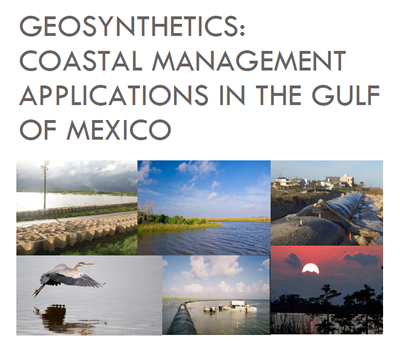 Washington, D.C. – What are geosynthetics and why are they central to the creation of jobs and expansion of coastal restoration projects? A new Duke University study, "GEOSYNTHETICS: Coastal Management Applications in the Gulf of Mexico" details how the emerging geosynthetics industry can create jobs benefitting nearly 200 employee locations in 36 states, including more than 72 in the five gulf states and 24 in Louisiana. Duke has also created an online interactive map showing firm-level data and firm locations by state and value chain segment.
Washington, D.C. – What are geosynthetics and why are they central to the creation of jobs and expansion of coastal restoration projects? A new Duke University study, "GEOSYNTHETICS: Coastal Management Applications in the Gulf of Mexico" details how the emerging geosynthetics industry can create jobs benefitting nearly 200 employee locations in 36 states, including more than 72 in the five gulf states and 24 in Louisiana. Duke has also created an online interactive map showing firm-level data and firm locations by state and value chain segment.
Geosynthetics are plastic materials manufactured into fabrics or sheets of various sizes, strengths and textures that are used in engineering projects. Some geosynthetic products include sand-filled geotextile tubes used as containment dikes for restoration projects, as well as marine mattresses — large, rectangular geogrid pouches filled with rocks that are used to support structures and control erosion. Increased investment in coastal restoration, as expected through the recently approved RESTORE Act, will stimulate more local projects and job sites using these innovative construction materials, which will in turn stimulate job creation and the economy.
The report, funded by Environmental Defense Fund and The Walton Family Foundation, is a study of 84 firms involved in the geosynthetics supply chain. The report finds that increased investment in coastal restoration will provide quadruple economic returns and create new opportunities for the growing geosynthetics industry.
Seventy-three percent of firms sampled in the study are considered small businesses according to the U.S. Small Business Administration guidelines on number of employees, and nearly half the firms have fewer than 100 employees. In addition to qualifying as small businesses, almost a quarter of geosynthetics manufacturing firms cited were established in just the last 10 years.
“The geosynthetics industry has been heavily involved in coastal restoration projects throughout Louisiana and the gulf states. As more projects are launched in response to RESTORE Act passage, our member companies are poised to grow our business and local staff to meet increased demand,” said Laurie Honningford, managing director for the International Association of Geosynthetics Installers (IAGI).
“As restoration projects ramp up all along the Gulf Coast and Mississippi River Delta as a result of the RESTORE Act, so will the coastal engineering and construction profession and the geosynthetics industry on which it relies,” said Jackie Prince Roberts, director of sustainable technologies for Environmental Defense Fund. “Geosynthetics — geotextiles and other manmade, polymer-based materials used in environmental restoration, flood prevention and erosion control projects — are an emerging industry and projected to grow at an annual rate of 6.8 percent through 2015. Long-term investment in coastal management will not only benefit the environment, but it will also spur economic growth all along the geosynthetics supply chain by both protecting current jobs — like Gulf Coast fishing, tourism and shipping — and creating new jobs. It’s an economic and environmental win-win.”
The study’s release is timely because earlier this month, the U.S. Congress passed and the President signed into law the RESTORE Act as part of the Surface Transportation Extension Act. This historic legislation will direct 80 percent of the Clean Water Act penalties paid by BP and others responsible for the 2010 gulf oil disaster to the Gulf Coast states to use for restoration. It is the single largest investment in environmental restoration ever made by the U.S. Congress.
“Our geotextile products are incorporated into a welded-wire system which provides a low-cost solution to a wide range of coastal restoration and protection challenges, from oyster reef construction to flood protection,” said Stephanie Victory, president of HESCO Bastion Environmental Inc. “We have completed projects all over the world. Some of the most recent range from emergency flood responses in Thailand to building HESCO Delta® Unit oyster reefs just north of Gulf Shores, Ala. We are thrilled that the RESTORE Act passage will create more opportunities for jobs and coastal restoration efforts back home in Louisiana and across the gulf region.”
“The geosynthetics industry is growing and evolving rapidly as it finds more applications for its product,” says the report. “Coastal management programs across the Gulf Coast states are growing as well, developing plans worth billions of dollars for ecosystem restoration, flood prevention, and erosion control. With geosynthetics playing an increasing role in coastal management, this convergence of events presents an opportunity for geosynthetics manufacturers to diversify and grow, and for coastal engineering to evolve and improve.”
The study also serves as a follow-up to two previous Duke University studies, “RESTORING THE GULF COAST: New Markets for Established Firms” and “RESTORING GULF OYSTER REEFS: Opportunities for Innovation.” The former, released in December, determined that using Clean Water Act penalties from the 2010 gulf oil spill could create jobs that would benefit at least 140 businesses with nearly 400 employee locations in 37 states, including more than 260 locations in the Gulf Coast. The latter, released in June, identified 130 firms nationwide involved with oyster reef restoration and poised to grow with passage of the RESTORE Act.
For more information on how investing in environmental restoration provides quadruple economic returns, please visit www.MississippiRiverDelta.org/economics.
ABOUT ENVIRONMENTAL DEFENSE FUND
Environmental Defense Fund (edf.org), a leading national nonprofit organization, creates transformational solutions to the most serious environmental problems. EDF links science, economics, law and innovative private-sector partnerships. Connect with us at Twitter.com/EDF_Louisiana and on Facebook.











